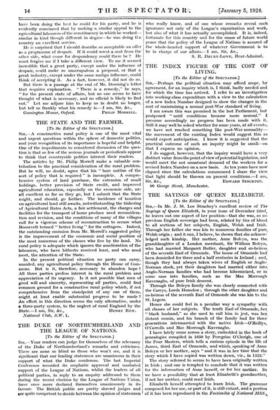THE SAYINGS OF QUEEN ELIZABETH.
[To the Editor of the SPECTATOR.] SIR,—In Mr. J. St. Loe Strachey's excellent review of The Sayings of Queen Elizabeth, in your issue of December 22nd, he leaves out one aspect of her position—that she was, as no previous English sovereign had been, related by ties of blood to all sections of her subjects, English, Welsh and Irish. Through her father she was kin to numerous families of pure, Welsh origin ; and it can, I believe, be shown that she acknow- ledged such kinship. Her mother, Anne Boleyn, was the granddaughter of a London merchant, Sir William Boleyn, who had married Margaret Butler, daughter and co-heiress. of the seventh Earl of Ormonde. The house of Ormonde had been domiciled for three and a half centuries in Ireland ; and,' though they had always taken wives of English or Anglo-. Norman stock, yet their daughters had married either into: Anglo-Norman families who had become hibernicized, or in some case into families, such as the Mac Morrough Kavenaghs, of pure Irish descent.
Through the Boleyn family she was closely connected with the Careys, Lords Hunsdon ; through the other daughter and co-heiress of the seventh Earl of Ormonde she was kin to the. St. Lcgers.
Hence she could feel in a peculiar way a sympathy with all classes of her subjects. The tenth Earl of Ormonde, her " black husband," as she used to call him in jest, was her, distant cousin, and his branch of the family had for three generations intermarried with the native Irish—O'Reillys, O'Carrolls and Mac Morrough Kavenaghs.
I have lately come across a story, embedded in the book of
genealogies compiled in 1650 by Peregrine O'Clerigh, one of the Four Masters, which tells a curious episode in the life of James, third Earl of Ormonde, and which, speaking of Anne Boleyn or her mother, says " and it was in her time that the story which I have copied was written down, viz., in 1528."
The story referred to seems to have been originally written
in Irish ; and one is tempted to conclude that it was written for the information of Anne herself, or for her mother. So we have a possibility that at least Elizabeth's grandmother, if not her mother, could read Irish.
Elizabeth herself attempted to learn Irish. The grammar composed for her use, or part of it, is still extant, and a portion of it has been reproduced in the Facsimiles of National MSS.4.
Ireland, published by the State. We are reminded of Queen Victoria setting herself to the task of learning Hindustani. Possibly much of Queen Elizabeth's popularity was due to the fact that her subjects could look on her as in essentials one of themselves, separated from them by no impossible barriers of blood, but on the contrary united by ties of kinship to the three races under her sway.—I am, Sir, &c., W. F. BUTLER. Royal Societies Club, St. James's Street, S.W.















































 Previous page
Previous page